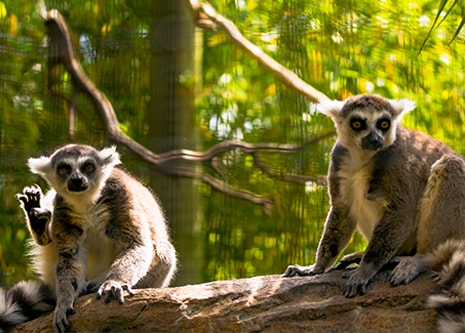
- VisitSupport Happy HollowDONATE TODAYExploreSupport Happy HollowDONATE TODAYLearnSupport Happy HollowDONATE TODAYSupportToday’s Hours: CLOSEDZoo in the Hollow
Jaguar

Scientific name: Panthera onca
Family: Felidae
Order: Carnivora
Class: Mammalia
Range: Central and South America
Habitat: Grassland, temperate and tropical forest and rainforest, wetland, woodland.
Lifespan: 12 to 15 years in the wild; up to 23 years in captivityWhat do they look like?
Jaguars are the largest cat species found in the Americas. Their size is variable depending on their habitat; forest-dwelling cats are smaller than their grass- or wetlands counterparts. Jaguars found in southern regions are also typically larger than those found in the north. They weigh 80 to 350lbs, although they are typically between 100 to 250 pounds with males being larger than females. They are five to six feet long and 26 to 30 inches tall at the shoulders. They are typically tawny-colored and blanketed with black rosettes. Melanism (hyperpigmentation of the fur) occurs in this species resulting in black fur. Often, melanistic jaguars are referred to as “black panthers.”How do they behave?
Like most large cats, jaguars are solitary animals. Mature jaguars only interact to mate or dispute territory. They are the only species in the genus Panthera (big cats with the ability to roar) in the Americas, though their roar often resembles a cough or grunt. Jaguars are both crepuscular (active during dawn and dusk) and nocturnal (active at night). Jaguars are “stalk-and-ambush” hunters and are able to capture prey up to twice their size. Studies have shown their bite is the strongest of all felines when compared to their size. Their stocky structure makes them skilled at climbing, crawling and swimming.What do they eat?
Jaguars are obligate carnivores. In the wild, they have an extensive list of prey including but not limited to capybaras, tapirs, peccaries, armadillos, monkeys, birds, snakes, caiman, turtles and fish. At Happy Hollow, they are fed meat, bones and fish.How are they born?
Jaguars are able to breed year-round. Courting is brief, and the male and female separate after mating. Gestation lasts 93 to 105 days and results in a litter of up to four cubs, though twins are most common. Cubs are born blind and helpless, reliant on their mother’s care for survival. They will stay in the den for up to six months before joining their mother on hunts to learn to catch prey. Jaguars will stay with their mother for up to two years before establishing their own territory and will reach sexual maturity around three years of age.Conservation
The jaguar’s conservation status is listed as Near Threatened by the International Union for conservation of Nature . One of the main threats faced by the jaguar is habitat loss and hunting by humans. One organization working to protect jaguars is the Society for the Preservation of Endangered Carnivores and their International Ecological Study (S.P.E.C.I.E.S.) Chaco Jaguar Project. This organization aims to establish corridors (habitat that links protected areas to one another) for jaguars to safely travel throughout Central and South America. S.P.E.C.I.E.S. also works with local communities to help mitigate human jaguar conflict. If you would like to participate in jaguar conservation, you can encourage your friends to purchase coffee that is shade grown, and produce that is grown locally. These products do not require the destruction of rainforest land (jaguar habitat) to grow crops and they will help out your local economy.
Zoo on the Hill
Located across from the Keep-Around Carousel is the Zoo on the Hill. Learn about wildlife up close during daily meet-and-greets, leap like a lemur on the playground, brush and feed the goats,, or take a peek inside Doc’s Critter Care building and the Ranch House. Double-H Ranch features a combination of animal exhibits, including giant anteaters and red ruffed lemurs, as well chickens and domesticated animals that are docile enough to touch.
See Animals
Education Ambassadors
From camps and classes to scout badges and sleepovers, Happy Hollow education programs have something for everyone! The zoo education program offers a broad range of hands-on, engaging programs and public presentations featuring education ambassador animals. These encounters are designed to connect you to wildlife and the conservation of their habitats around the world.
See AnimalsVisit Us Today
Plan an unforgettable experience at San Jose’s family-friendly park and zoo.
Learn More